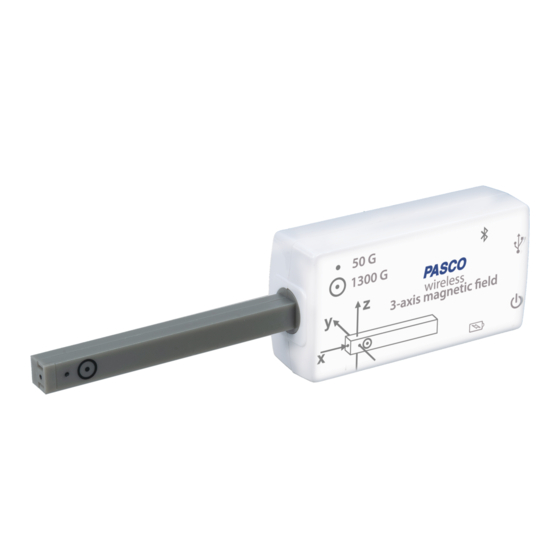
Advertisement
Quick Links
Wireless 3-Axis Magnetic Field Sensor
Introduction
The Wireless 3-Axis Magnetic Field Sensor is a combination
wireless and USB sensor that connects to a computer or tablet
device through Bluetooth, and can also connect to a computer
with an included USB cable. The sensor measures the X, Y, and
Z components of the magnetic flux density in tesla, millitesla,
and gauss. The arrangement of the X, Y, and Z components is
shown on the top label.
The two magnetic field sensing elements are located in the end
of the probe. One sensing element is a three-axis ±50 gauss (G)
sensor located under the dot on the probe. The other sensing
element is a three-axis ±1300 G sensor located under the dot
surrounded by a ring. The bottom surface of the probe has
bumps at one centimeter intervals relative to the sensing
element location.
Equipment
Included equipment:
Wireless 3-Axis Magnetic Field Sensor
Sensor mounting rod
Micro USB cable (not pictured)
Features:
Sensing element indicators
Show the location of the sensing elements within the probe.
Probe
Contains the sensing elements used to measure magnetic
flux density.
Device ID
Use this to identify the sensor when connecting via
Bluetooth.
Bluetooth Status LED
Indicates the status of the sensor's Bluetooth connection.
Bluetooth LED
Red blink
Green blink
Yellow blink
For information on remote data logging, see the PASCO
Capstone or SPARKvue online help.
NOTE: The Bluetooth Status LED is disabled
when the sensor is connected to a computer via
the micro USB cable.
Battery Status LED
Indicates the battery level and charge status of the sensor.
Battery LED
Red blink
Yellow ON
Green ON
ON/OFF button
Press to turn the sensor on. Press and hold to turn the
sensor off. To preserve battery, the sensor turns itself off
after several minutes of inactivity if not connected.
Micro USB port
Use with the included micro USB cable (not pictured) to
connect the sensor to a USB charger. The port and cable
can also be used to directly connect the sensor to a
computer without the use of Bluetooth. This connection
method is not supported by iOS.
Bumps at 1 cm intervals
Used to indicate distances.
Threaded hole (1/4-20)
Used to mount the sensor to the included mounting rod.
Required item:
• PASCO Capstone or SPARKvue data collection software
Recommended items:
• Wireless Rotary Motion Sensor (PS-3220)
• Air Core Solenoid (SE-7585)
• Ampere's Law Accessory (EM-6720)
• Helmholtz Coils (EM-6722)
• Zero Gauss Chamber (EM-8652)
• Variable Gap Magnet (EM-8618)
• Bar magnets, such as SF-7263
• Coil and cores set, such as SF-8617
Product Guide | 012-16036B
(PS-3221)
Status
Ready to pair
Connected
Logging data
Status
Low power
Charging
Fully charged
1
Advertisement

Summary of Contents for PASCO PS-3221
- Page 1 Yellow blink Logging data The two magnetic field sensing elements are located in the end For information on remote data logging, see the PASCO of the probe. One sensing element is a three-axis ±50 gauss (G) Capstone or SPARKvue online help.
- Page 2 4. Select the sensor that matches its device ID. A notification Using the sensor appears if a firmware update is available. Click Yes to The sensor is designed to work with PASCO data collection update the firmware. software (PASCO Capstone and SPARKvue) to measure 5.
- Page 3 Connecting the sensor to a computer via micro USB cable: Software help 1. Turn on the Wireless Magnetic Field Sensor. The SPARKvue and PASCO Capstone Help provide additional information on how to use this product with the software. You 2. Open Capstone. If desired, open Hardware Setup can access the help within the software or online.
- Page 4 PASCO scientific, is prohibited. Trademarks PASCO and PASCO scientific are trademarks or registered trademarks of PASCO scientific, in the United States and in other countries. All other brands, products, or service names are or may be trademarks or service marks of, and are used to identify, products or services of, their respective owners.




Need help?
Do you have a question about the PS-3221 and is the answer not in the manual?
Questions and answers